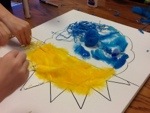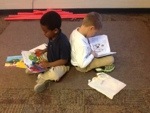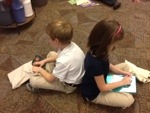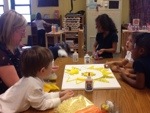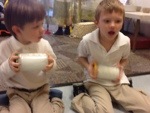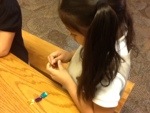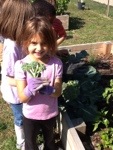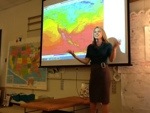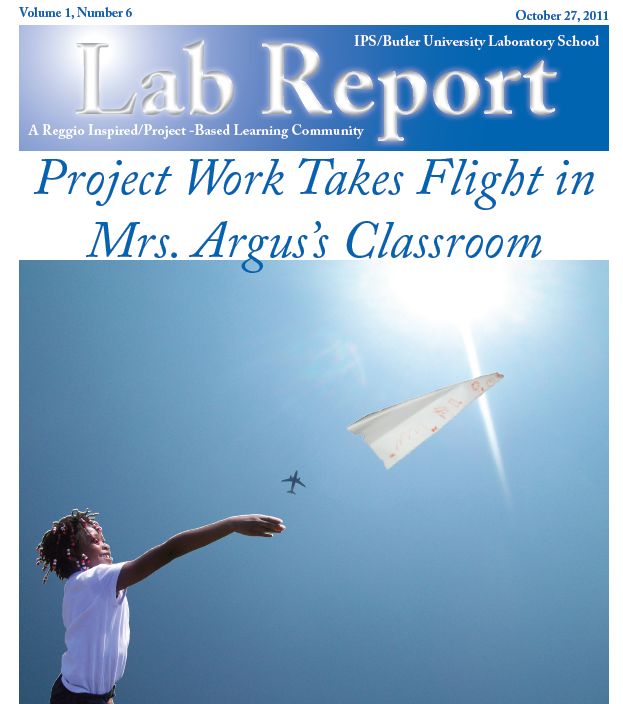Hi Families! We’ve had a full couple of weeks here in room 107. Please accept my sincere apologies in my poor frequency of blogging lately. I promise to be better once we return from Fall Break! In the mean time, I’d love to fill you in on some of our high lights from the past couple of weeks.
Our shark project has been moving along rather nicely. Students continue to use their free time to read shark books and record any facts they are finding in their shark journals. A particular high light of the week was that a biology professor from Butler came to visit us and talk about sharks. While here, she used a measuring tape to show the class how long a great white shark is (20ft.), showed the students shark teeth and shark eggs, let kids touch a shark skull, and answered many questions for us. Some of our questions and answers included:
Q: Why are sharks gray? – Olivia
A: Sharks are gray because they need to be sneaky while they are hunting, and being gray makes them harder to see so they can blend in with the water.
Q: Why did sharks from long ago have more fins (on their backs)? – Chloe
A: Lots of fish from long ago has spikes all down their back. The sharks’ multiple fins is an example of that.
Q: Why do mommy sharks leave their babies? – Hayes
A: Many animal mothers leave their babies. However, baby sharks all stay together so that they can stay safe.
Q: Why do sharks live in salt water? – Madeline
A: Sharks ancestors lived in salt water and they haven’t adapted to fresh water yet, although some can swim up rivers a short distance.
In readers workshop, we have been continuing to learn different reading strategies through animals. So far, we have learned how to get our mouths ready at the beginning of a word like Ready Rooster. We have learned to stretch out all the different sounds we hear in a word like Stretchy Snake. We have learned to look for familiar letter chunks in words like Chunky Monkey. And this week we learned that if we have been trying to read a word for a long time, like Tryin’ Lion, then we can skip a word and come back to it like Lion’s friend Skippy Frog. Yesterday, one of our Butler teachers read a book, demonstrating that you can skip a word and then come back to it and read it using pictures to help you. Then today, I showed students how they could skip a word and then use the rest of the words to build understanding and help read tricky words. The students seem to be grasping on to these animal strategies. They really love when a new animal comes to visit us. Feel free to mention some of these animals when you are reading with your children at home! And be on the look out, because there are more animals to come!
In math workshop, we have been working on missing addend story problems. In addition to this, we have been reviewing basic addition and subtraction story problems. The missing addend problems are challenging, but students are doing a nice job developing strategies to attack these sort of story problems. If you would like to continue practicing missing addend addition at home, try playing this game with your child. Have you child put a certain number of items together. (Ex. He/She puts 4 shoes on the floor). Then have your child close their eyes or leave the room and you can add more of that item to the group. When you are done, have your child come back in and count how many are in the group now. Then ask them to figure out how many you added when they weren’t looking. See if they can explain their thinking. It will help them to avoid randomly guessing!
In story workshop, we have been doing an illustration study and an author study. We spent two weeks practicing drawing faces, emotions, and bodies. We talked about the importance of color and different ways to use it. We also talked about different ways that illustrators show movement through their pictures. This week, we have been reading Kevin Henkes books during Story Workshop. Students have noticed and appreciated the way Mr. Henkes uses color in his books, makes his pictures match his words, puts multiple small pictures together to make a larger picture or a series of pictures. We have also talked about how Kevin applies strategies we have already been talking about this year, such as including a beginning, middle, and end in his books. Today, Chloe pointed out that he does a nice job of putting problems in his stories, and Spencer helped us see the way today’s problem was resolved.
Last but not least, I want to fill you in on today’s gardening day. This morning, our class participated in a variety of jobs that helped our overall gardening work for the day. Some friends pulled weeds by the William A. Bell monument. Other helped tear up our courtyard for further beautification. Some friend assisted in the building six new garden beds, while others planted flowers at our front entrance. Our final group did heavy lifting as they dug up and moved rocks in a new flower bed. The weather was beautiful, and the kids worked hard and had a great time!
I hope you all have wonderful Fall Breaks, and I look forward to sharing more of our learning with you once we return to school on October 22nd!

